Recent Water Damage Posts
Safeguarding Your Home: 7 Essential Tips to Mitigate Flooding Risks in Colorado Springs
5/18/2024 (Permalink)
 Mitigate Flooding Risks in Colorado Springs, Colorado.
Mitigate Flooding Risks in Colorado Springs, Colorado.
Nestled in the scenic landscapes of Colorado, Colorado Springs offers residents a blend of natural beauty and outdoor adventures. However, along with its picturesque surroundings comes the risk of flooding, particularly during heavy rainstorms or rapid snowmelt. Protecting your home from flooding is paramount to safeguarding your family and property. Here are seven essential tips to help reduce flooding risks in your Colorado Springs home.
1. Understand Your Property's Flood Risk:
Before implementing any flood mitigation measures, it's crucial to understand your property's flood risk. FEMA's Flood Insurance Rate Map (FIRM) provides valuable information about flood zones in your area. Additionally, consulting with local authorities or hiring a professional can help assess your property's susceptibility to flooding. Armed with this knowledge, you can tailor your flood preparedness efforts accordingly.
2. Elevate Vulnerable Utilities:
Electrical systems, HVAC units, and other utilities are vulnerable to water damage during flooding. Elevating these critical components above flood levels can minimize the risk of costly repairs and potential safety hazards. Consider installing electrical outlets and circuit breakers at higher elevations and relocating HVAC units to elevated platforms. Elevating utilities not only protects your home but also ensures essential services remain operational during and after a flood event.
3. Invest in Flood Barriers and Sealants:
Sealing your home against water intrusion is an effective way to mitigate flooding risks. Installing flood barriers such as flood gates, sandbags, or inflatable barriers can prevent water from entering vulnerable entry points like doors, windows, and vents. Additionally, applying waterproof sealants to basements, walls, and foundations can reinforce your home's defenses against water seepage. Regularly inspect and maintain these barriers and sealants to ensure they remain effective over time.
4. Implement Landscape Grading and Drainage Solutions:
Proper landscape grading and drainage are essential for directing water away from your home's foundation. Sloping the ground away from your property and installing French drains, swales, or rain gardens can help channel water away from vulnerable areas. Clearing debris from gutters, downspouts, and storm drains is also critical to prevent water buildup and potential blockages. By addressing drainage issues on your property, you can reduce the likelihood of water pooling around your home during heavy rainfall.
5. Install Sump Pumps and Backup Systems:
Sump pumps are invaluable tools for removing excess water from basements and crawl spaces. Installing a reliable sump pump with a battery backup system can provide an added layer of protection against flooding. In the event of a power outage, the backup system ensures continuous operation, preventing water damage even during emergencies. Regular maintenance, including testing the pump and replacing batteries as needed, is essential to ensure optimal performance when you need it most.
6. Elevate or Waterproof Basement Structures:
Basements are particularly susceptible to flooding due to their below-ground location. Elevating basement floors above the flood level or installing waterproofing measures such as sump pumps, interior drainage systems, and sealants can help protect valuable belongings and structural integrity. Consider retrofitting basement windows with flood vents to equalize water pressure and prevent hydrostatic pressure buildup during floods. Investing in basement waterproofing not only safeguards your home but also enhances its resale value and livability.
7. Obtain Flood Insurance Coverage:
Despite your best efforts to mitigate flood risks, unforeseen circumstances can still lead to water damage. Securing adequate flood insurance coverage provides financial protection against losses resulting from flooding events. While standard homeowners' insurance policies typically exclude flood damage, obtaining a separate flood insurance policy through the National Flood Insurance Program (NFIP) or private insurers can offer peace of mind and financial security. Review your insurance coverage annually to ensure it adequately reflects your property's flood risk and coverage needs.
In Colorado Springs, where the beauty of nature coexists with the threat of flooding, taking proactive measures to protect your home is essential. By understanding your property's flood risk, elevating utilities, investing in flood barriers and sealants, implementing landscape grading and drainage solutions, installing sump pumps and backup systems, waterproofing basement structures, and obtaining flood insurance coverage, you can significantly reduce the impact of flooding on your home and family. Remember, preparedness is key to weathering the storm and safeguarding what matters most.
Navigating Water Damage in Colorado Springs with SERVPRO's Expertise
1/12/2024 (Permalink)
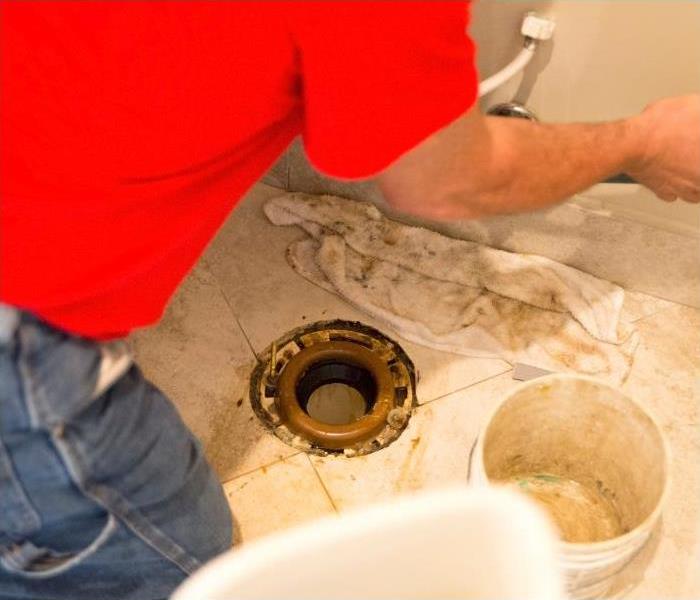 Leaking toilet in Colorado Springs, CO.
Leaking toilet in Colorado Springs, CO.
Colorado Springs, CO, with its stunning landscapes and thriving community, is a place where homeowners take pride in their properties. However, the serenity of this picturesque city can be disrupted by unexpected events, such as water damage caused by a leaking toilet. In this comprehensive blog, we'll delve into the nuances of water damage, its potential consequences, and how we, a renowned restoration company, can be your beacon of hope in restoring your home to its former glory.
Understanding the Impact of Water Damage
Leaking Toilets: The Unseen Menace
Leaking toilets often go unnoticed until the damage is already underway. Whether it's a slow leak or a sudden burst, the consequences can be severe. In a city like Colorado Springs, where homes are nestled against the backdrop of nature, the effects of water damage can be compounded.
Immediate Consequences
The moment water infiltrates your home, it starts to seep into various materials. From drywall to flooring and even the foundation, the immediate impact is far-reaching.
Structural Integrity Under Threat
Over time, prolonged exposure to water can compromise the structural integrity of your home. What might start as a small leak can escalate into a major issue, necessitating costly repairs.
Mold's Silent Invasion
Colorado's unique climate, characterized by dry air and high altitude, doesn't exempt homes from the risk of mold growth. Water damage creates the ideal conditions for mold and mildew, posing not just structural but also health risks to residents.
Our Advantage:
Rapid Response in the Rockies
We understand the urgency of water damage. Their 24/7 emergency services ensure that a team of experts is at your doorstep promptly, ready to mitigate the damage and prevent further escalation.
State-of-the-Art Equipment
Equipped with cutting-edge technology, we employ advanced drying equipment, moisture meters, and thermal imaging to assess and address water damage with precision. This ensures that no corner of your home is overlooked during the restoration process.
Comprehensive Restoration Expertise
The skilled technicians bring a wealth of experience to the table. From water extraction to thorough drying and sanitization, they handle every aspect of the restoration process meticulously.
Navigating the Insurance Maze
Dealing with insurance claims can be a daunting task, especially when you're already dealing with the aftermath of water damage. SERVPRO's professionals work closely with insurance companies, streamlining the claims process and alleviating the burden on homeowners.
The Restoration Journey:
Emergency Response
When you discover a leaking toilet or any other water damage in your Colorado Springs home, time is of the essence. SERVPRO's rapid response ensures that the damage is assessed promptly, and the necessary measures are put in place to prevent further harm.
Water Extraction and Drying
Utilizing state-of-the-art equipment, SERVPRO's technicians commence with water extraction to remove excess moisture. This is followed by an intensive drying process, using dehumidifiers and air movers to ensure that all affected areas are thoroughly dried.
Sanitization and Deodorization
Water damage often brings unpleasant odors and the risk of microbial growth. We don't just stop at drying; they go the extra mile to sanitize affected areas, ensuring a clean and safe environment for you and your family.
Restoration, Not Just Repairs
We believe in restoring, not just repairing. Their team works diligently to bring your home back to its pre-damage condition, addressing not only visible damage but also potential hidden issues.
Ongoing Monitoring
Even after the visible signs of water damage are addressed, we don't walk away. They continue to monitor moisture levels to ensure that your home remains dry and free from the risk of future issues.
Restoring Peace of Mind in Colorado Springs
Choosing us for water damage restoration in Colorado Springs is not just about fixing your home; it's about restoring your peace of mind. In a city known for its tranquility and natural beauty, homeowners can rest assured that their property is in capable hands.
Water damage from a leaking toilet may disrupt the harmony of your Colorado Springs home, but with SERVPRO's expertise, it can be transformed from a source of stress to a story of restoration. Don't let water damage linger – take the first step toward reclaiming your home and ensuring a future free from the lingering effects of leaks. Choose us for a comprehensive and effective restoration journey that brings your property back to its luxurious best.
My Basement Has Flooded! Now What?
8/31/2023 (Permalink)
 Be sure to clean water damage after a flood in your Colorado Springs, CO home as quickly as possible to avoid further damage.
Be sure to clean water damage after a flood in your Colorado Springs, CO home as quickly as possible to avoid further damage.
When you discover that your Colorado Springs, CO, basement has flooded, panic tends to ensue, especially if water is still flowing in. How do you stop and extract the water? Is anything going to be salvageable? How do you even restore the area after flooding? These are some of the main questions people ask during a basement flood. Fortunately, all hope is not lost; there are ways to restore much of a water-damaged area and its contents. When it comes to water damage, every second counts, so act quickly.
What Are the Steps for Remediation?
- Prioritize Safety
Most importantly, you and others in the area must remain safe. Before you even step into the basement, turn off the electricity to the basement or the entire house. Electricity can flow through standing water if it's in contact with electronics, appliances, or electrical outlets. If you can't safely navigate to the circuit breaker, call a professional electrician or your power company to turn your electricity off.
- Stop the Water
If the water is still flowing into the basement and it's from a burst pipe or another plumbing issue, shut off the main water supply to stop the water. You can call for pipe repair after you've started the restoration process.
- Wear PPE
If the flood originated outdoors or contains sewage or another toxic substance, it's vital to wear personal protective equipment. This PPE not only keeps you and others in the area safe but also prevents cross-contamination to other parts of the house.
- Eliminate Standing Water
You must extract standing water as quickly as possible. Every minute counts when it comes to water damage, as the damage progresses rapidly. The time it takes to eliminate the water could mean the difference between something being salvageable or not.
- Remove Contents
Remove all affected items from the area. This not only includes basement contents but could also include carpeting and carpet padding, hardwood flooring, and drywall. Flooding will soak carpet and padding; it probably won't be dried quickly enough to save. Wet wood tends to warp and buckle and probably won't be salvageable. Drywall will soak up water like a sponge. You will likely have to cut out the wet parts of your drywall and replace them. Contents such as upholstered and wooden furniture will have to be assessed for salvageability.
- Begin Drying
Mold can start growing within 24 hours of moisture exposure, so everything needs to be completely dried as quickly as possible. If you can't dry it within 48 hours, it probably won't be salvageable. The basement itself will also have to be dried thoroughly as quickly as possible to avoid mold growth. It's best to hire water damage restoration professionals to do this job, as they have the expertise and industrial equipment to handle the job safely and efficiently. In the meantime, you can run fans and dehumidifiers to dry the area faster. Heat will also help the drying process.
- Clean Everything
You'll need to clean and disinfect everything to ensure no lingering bacteria, mold spores or other harmful substances remain. Everything that the water touched must be cleaned, including walls and furniture.
When you discover flooding in your basement, time is precious. The sooner you can begin drying, the more of the affected items you can save.
How To Keep Your Pipes From Freezing
9/14/2022 (Permalink)
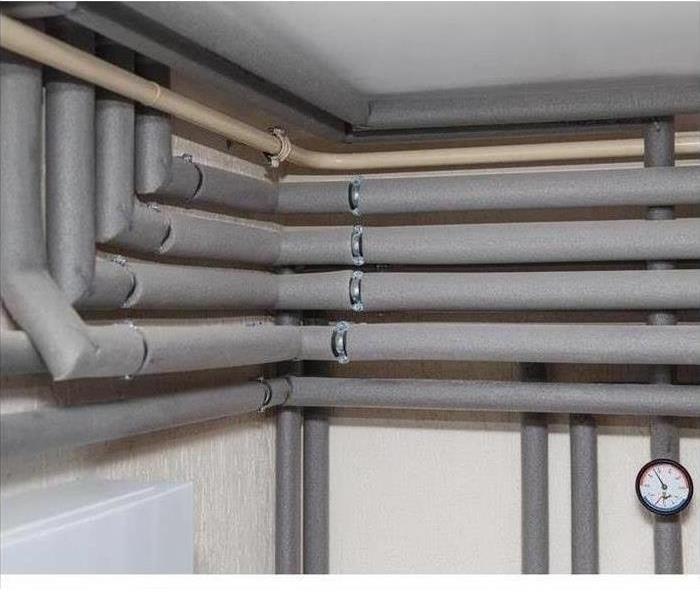 Pipes from a local commercial building.
Pipes from a local commercial building.
Winter may mean shorter days and cooler temperatures in Colorado Springs, CO, but it doesn't have to mean bursting pipes and water damage too. Here are six ways to prevent your pipes from freezing this winter.
6 Ways To Prevent Your Pipes From Freezing
1. Let the faucet run overnight
It's true what they say: It's always coldest just before the dawn. If you have pipes that are exposed to the elements, even a tiny trickle of water from a faucet that's connected to those pipes can stop them from freezing if left running overnight.
2. Shut the garage door
This is especially useful if your garage is home to water supply lines. Keeping the door shut keeps the cold out and the temperature up — at least a little bit.
3. Open the cabinets under the sink
Leaving the cabinet doors open beneath your kitchen, bathroom, or utility sink allows more of the warm air in your home to reach the pipes and can potentially stop them from freezing.
4. Keep the temperature in your home consistent
Turning the thermostat down a few degrees before you jump under the covers at night may save you a couple of bucks on your energy bill, but in the winter, that drop in temperature can also lead to freezing and bursting pipes.
5. Insulate your pipes
Some areas of your home, such as the basement and attic, are naturally colder than the rest of your home. Wrapping the pipes in these areas with insulation can keep them heated enough to avoid freezing over.
6. Eliminate drafts
Keep your home toasty warm and your pipes thoroughly thawed by making sure the seals around windows and doors are tight. It's also a good idea to inspect your home annually for other cracks and seal them promptly.
Very few people have money conveniently tucked away in a "fix broken pipe" fund. Following these six tips can help eliminate the threat of freezing and bursting pipes, as well as the need to enlist the help of a professional water damage recovery company.
7 Steps for Replacing a Toilet
8/17/2022 (Permalink)
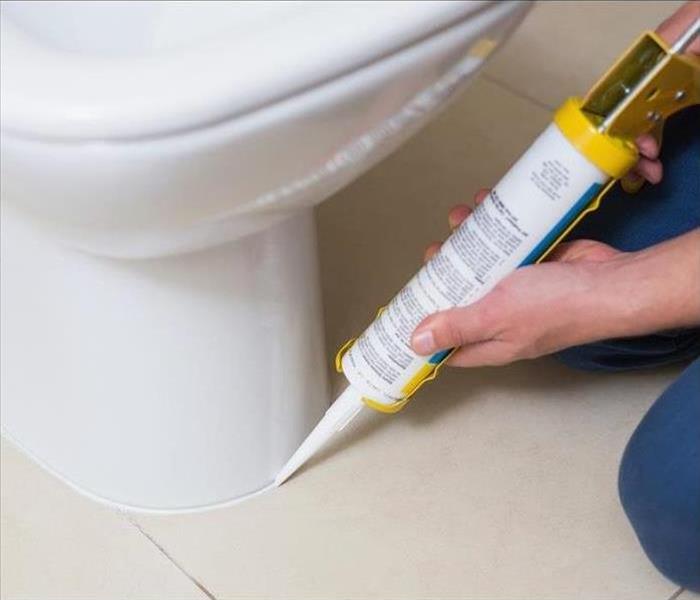 Apply caulk to the new toilet bowl to avoid leaks.
Apply caulk to the new toilet bowl to avoid leaks.
If you discover a leaking toilet at your home in Colorado Springs, CO, toilet repair may not be an option if the leak is severe. You might have to replace the old toilet. Even if you're new to this type of job, it should still be relatively easy.
Steps to Replace a Toilet
Here are the steps:
1. Shut Off the Water Supply
First, shut off the water at the supply line. Then, flush the toilet to drain the water. Next, the water supply line must be disconnected from the bottom of the toilet tank. You must then remove the bolts on the toilet's base.
2. Remove the Old Toilet and Wax Seal
You'll see a caulk seal around the bowl's base. It needs to be cut out. The toilet should be movable. Now it's time to remove the leaking toilet, then remove the wax seal. If you see that damage has occurred from the leak, you might need to call water damage remediation professionals to take care of it before installing the new toilet.
3. Apply Caulk to the New Bowl
Caulk then needs to be applied to the base of the new bowl. This will make the installation look cleaner and will keep leaks at bay.
4. Install the New Wax Ring and Bowl
Place the new wax ring between the bolts. Then, put the bowl into place. The wax seal will be compressed by the bowl's weight.
5. Grease the Spud Washer
At the base of the tank is a spud washer. Put a coat of plumber's grease on it. Then place the tank as you're lining up the mounting bolts.
6. Tighten the Tank's Bolts
Place the washer on the bolts and then tighten the nut. Then, fully tighten the inner-tank bolts and place the mounting bolts on the bowl's base.
7. Ensure the Toilet Is Level and Test for Leaks
Ensure the toilet is level. Reconnect the water line and turn on the water. When the tank fills, test for leaks by flushing the toilet.
A leaking toilet can be a real inconvenience. However, if it can't be repaired, it should be replaced as soon as possible before the problem worsens.
Tips for Water Damage Prevention
7/19/2022 (Permalink)
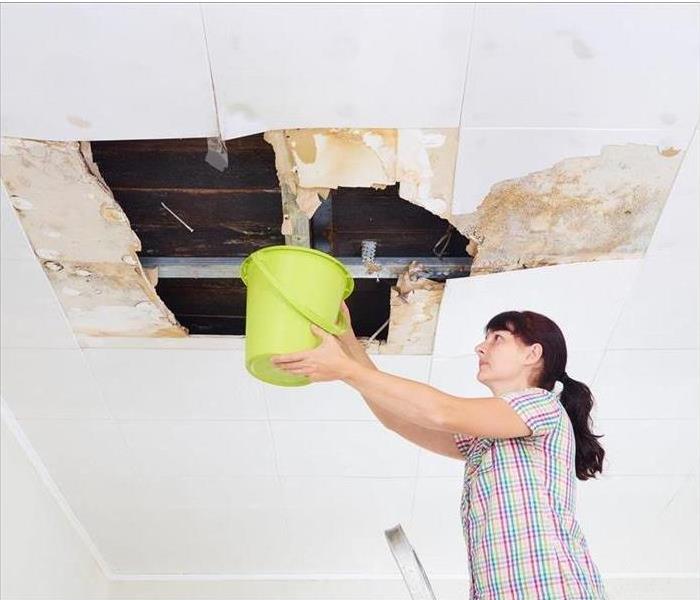 Fix leaks before having secondary damage.
Fix leaks before having secondary damage.
When homeowners think of water damage, they usually imagine a large flooding event from a storm or water main break, but small things such as undetected leaks can cause a lot of problems, too. Damage from water in your home in Colorado Springs, CO, is not inevitable, though. There are several things you can do to prevent it from happening.
4 Tips to Prevent Water Damage
- Have a Consistent Maintenance Schedule
Most water damage is entirely preventable. All you need to do is update your maintenance checklist to ensure that it includes leak prevention tasks:
- Clean gutters and downspouts
- Minimize landscaping near pipes or sewer lines
- Check pipes and supply lines for weak spots or leaks
- Maintain appliances
- Winterize pipes before the first big freeze of the year
- Improve Water Loss Detection
Another way to prevent damage is to head potential problems off at the pass. To do this well, you have to know when they start. An unusually high water bill could be a sign of a leak that leads to water in your home. A working sump pump in your basement protects it even when you are not there.
- Know Where Your Water Main is Located
A broken pipe is not always something you can prevent, but you can minimize the amount of water it releases by turning off your water main. The shutoff valve stops the flow of water into your pipes so that you can get the issue resolved.
- Fix Leaks and Damage Quickly
Even if your home is damaged by an unpredictable accident, quick pipe cleanup can help you prevent secondary damage. It's important to call water restoration experts as soon as you know there is an issue so that they can stop the progress of the seepage and prevent mold growth.
To prevent water in your home from causing extensive problems, you have to be diligent. Proper maintenance and vigilant attention to changes help you safeguard the structural integrity of your house.
What You Should Know About Overflowing Toilets and Sewage Backup
6/17/2022 (Permalink)
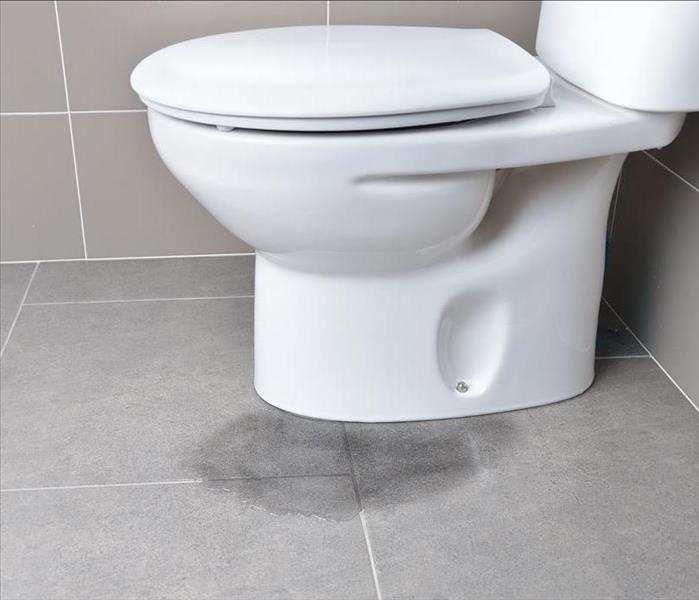 Our Specialists can help you if you experience an Overflowing Toilet and Sewage Backup.
Our Specialists can help you if you experience an Overflowing Toilet and Sewage Backup.
Property owners must be diligent about the upkeep of their homes, especially when it comes to making repairs and fixing problems. Water damage, in particular, can lead to major issues, especially if it’s due to something as serious as a flooded toilet or sewage backup.
If you ever have this problem in your home in Colorado Springs, CO, it’s important to know the steps to take to minimize the damage.
Dealing With an Overflowing Toilet and Sewer Damage
If your toilet has flooded your bathroom, follow these steps:
- Shut off the water: The easiest way to shut off the supply is usually by turning the valve underneath the toilet. Depending on the extent of the flooding as well as the toilet’s contents, this valve may not be accessible. In that case, locate the main water supply for your home, and turn that off.
- Rig your toilet float: If accessible, you can also open the tank and adjust the float’s position to prevent the tank from refilling.
- Turn off electricity to the bathroom: Water and electricity are a hazardous combination. If possible, turn off the electricity to the affected areas at the breaker.
- Remove excess water: Depending on the level of flooding, you may be able to remove excess water using towels, buckets, and wet vacs. Be sure to wear gloves and other protective gear to minimize contamination.
- Call a professional damage restoration provider: Water damage can get underneath floors and behind walls, causing other types of damage, including mold. A professional restoration service is equipped to fully clean and remediate all areas impacted by flooding.
- Notify a utility or sewage company: If the problem is a result of a backup, you should notify the utility provider or entity responsible for wastewater lines in your neighborhood.
Understanding Water Damage
Water damage falls under three categories:
Category 1: This generally includes damage from a leaky pipe or overflow from a sink. Also called clean water, this water is usually free of contaminants.
Category 2: Water damage in this category could include an overflowing toilet (without feces) or certain leaking appliances such as a dishwasher or washing machine. Category 2 water is also called grey water and contains some contaminants.
Category 3: Also called black water, category 3 water is severely contaminated and contains unsanitary agents. An overflowing toilet with feces, sewage backup, seawater, and flooding are examples of category 3 water damage.
Grey water from a toilet can become black water if left unattended.
Cleaning Up
Sewer damage and other forms of black water require special approaches to cleanup and disinfection that come from professionals. Your local provider can fully assess the damage caused by your toilet and use the appropriate methods for sanitization and drying to restore affected areas to pre-damage conditions. If your home requires structural repairs and rebuilding, the pros can handle that also.
An overflowing toilet can be a minor nuisance. It can also become a major problem, especially if there’s sewer damage and other types of black water, the most severe type of water damage. Shut off the water supply and do what you can to stop the inflow. Even if you’re able to remove the water, be sure to call a professional damage restoration company to safely remove contaminants and repair the damage.
Understanding Homeowners Insurance Coverage for Flood Damage
4/9/2022 (Permalink)
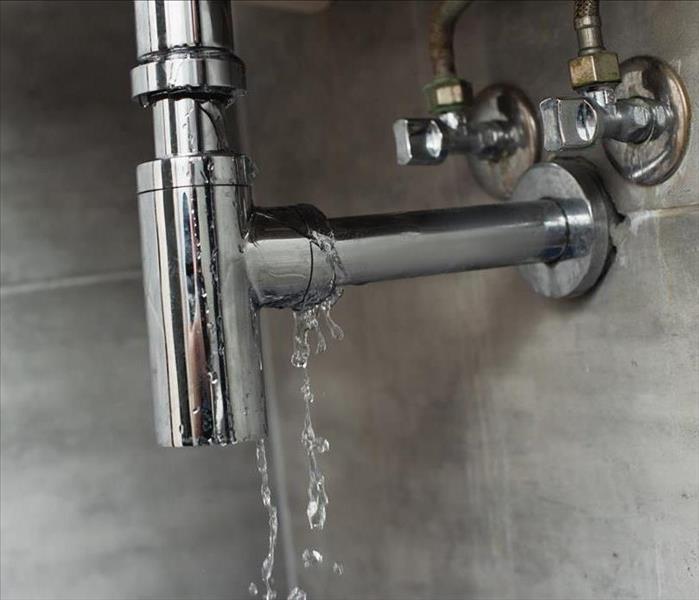 Follow these tips and learn more about Insurance Coverage for Flood Damage.
Follow these tips and learn more about Insurance Coverage for Flood Damage.
If your home is financed through a mortgage, then you’re required to carry a homeowners insurance policy by your lender. This insurance plan protects the lender’s interest in your property. Even if you don’t have a mortgage, having property insurance is a wise move for your home in Colorado Springs, CO. If your house is subject to certain types of damage, a policy spares you from having to pay out of pocket for repairs or replacement.
Carrying property coverage is part of being a responsible owner, but you also should know what is and isn’t covered. Flood damage, for instance, is generally not covered. Let’s take a closer look at water damage and homeowner coverage.
A Closer Look at Flooding and Insurance Coverage
Your homeowners policy does not cover damage from the following types of flooding:
- Storms and weather events
- Overflow from bodies of water such as lakes, rivers, and ponds
- Oversaturated ground
You would need to purchase a separate flood insurance policy for protection from flood damage. There are other types of water damage that you may experience in your home, some of which is not included in your coverage.
What’s Covered and What’s Not
Water damage in your home may also arise from a broken pipe, an overflowing toilet, or a malfunctioning appliance such as a dishwasher or washing machine. When it comes to your policy, coverage isn’t based on the extent of damage, but rather on whether the problem was immediate or gradual. Most insurance plans will only cover damage that is sudden and accidental.
Destruction that comes from a gradual problem probably won’t be covered by your plan. This is one reason why regular inspection of your house and its mechanical, electrical, plumbing, and HVAC systems are characteristic of responsible homeownership.
Other Exclusions
It’s important to understand the limitations and restrictions of your policy. We’ve established that sudden water damage is usually protected, but be aware of the following exclusions:
Poor maintenance: A broken pipe from a freeze seems like a no-brainer, but your claim could be denied for failure to wrap your pipes and take other preventive steps when the weather is very cold.
Source of damage: If a busted dishwasher supply line causes damage to your floors, your policy would cover floor replacement, but not the dishwasher.
Sewer or drain backup: If an outside sewer, drain, or pipeline backs up into your residence, your homeowners plan won’t cover any repairs. You might be able to purchase a separate policy to cover water backup.
When Disaster Strikes
No matter what type of water damage you experience, it’s important to contact a company that specializes in water damage repair. These professionals have the knowledge, expertise, and equipment to restore your house to pre-damage conditions. They know the best ways to expedite the process, looking for ways to lower costs by prioritizing repairs over replacement where possible.
Having homeowners’ insurance is a good idea whether you have a mortgage or not. While your policy may not cover flood damage, it can cover your costs for repair from other water problems. There’s no time like the present to become familiar with what your plan includes and excludes.
Frozen Pipes: Insurance Coverage and Prevention
11/17/2021 (Permalink)
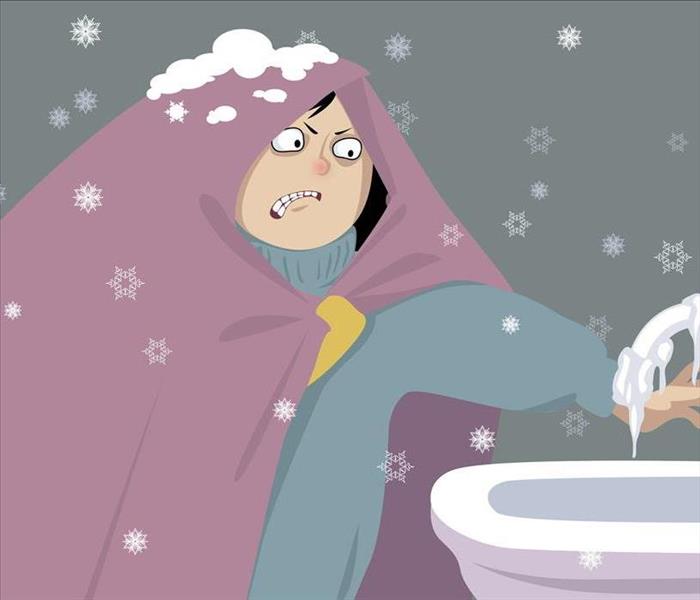 Prevent frozen pipes to avoid filing an insurance claim in your Colorado Springs, CO home.
Prevent frozen pipes to avoid filing an insurance claim in your Colorado Springs, CO home.
With the winter months ahead, many homeowners are checking to see what their insurance will and won’t cover in terms of winter damage, like frozen pipes. Most policies cover accidental or sudden damage to a home’s plumbing, meaning you can file an insurance claim for a bike break due to a pipe freeze. However, there is no guarantee that all costs will be covered by your policy.
While policies will vary, there are some everyday items covered. Most insurers will cover:
- Tearing out walls for burst pipe access
- Repairs to damaged property
- Repairs and restoration to walls
Most insurance companies will not cover the cost to repair the section of the broken pipe. Pipes that freeze are often the result of maintenance issues, meaning it is not covered by insurance. Therefore, it is vital to focus on prevention this winter. Contact a water remediation specialist in Colorado Springs, CO, for insight into more specifics.
Avoid an Insurance Claim By Following These 5 Protective Plumbing Practices
A burst pipe from freezing can result in significant property and water damage. Thankfully, preventing such issues is simple with some basic maintenance practices. If you plan on going on vacation this winter, make sure to adhere to the following five strategies.
1. Insulate
Do you have any exposed plumbing? Sometimes, a house will have pipes running through a garage or outdoors. You want to make sure that you insulate any exposed pipes with a foam roll or insulating tape.
It is also beneficial to insulate pipes under sinks or that are exposed in the basement. While these areas are often protected against lower temperatures, preparing for emergencies like outages is best.
2. Protect
Many houses have outdoor faucets or fixtures. You will want to disconnect any hoses from these fixtures to allow for proper drainage. Failing to remove hoses can result in frozen and broken faucets, resulting in property damage. If there is a separate shut-off valve, it is best to turn the water off and allow the fixture to drain.
3. Heat
One of the worst things you can do when leaving your house in the winter is turn off your heat. While you probably want to save money, your plumbing requires heat to function correctly. While you can turn down the thermostat, try to avoid going below 55° Fahrenheit.
4. Run
One of the best things you can do in the winter, especially in the coldest areas of your home, is run the water. You do not have to turn faucets on full force either. Essentially, you want to turn on your faucet so that it drips slowly. A slow drip will help keep water moving instead of freezing.
5. Drain
If you will be traveling this winter, it is likely best to shut off the main water supply to your home and drain the system. Draining the system is straightforward; you merely turn on the faucets in your home until no more water is coming out. Draining ensures there is nothing in the pipes to freeze.
While an insurance claim will typically cover the damage caused by a burst pipe, it will not cover the pipe repair. It is best to take preventative action to avoid a break, to begin with.
Understanding Clean Water Damage
10/11/2021 (Permalink)
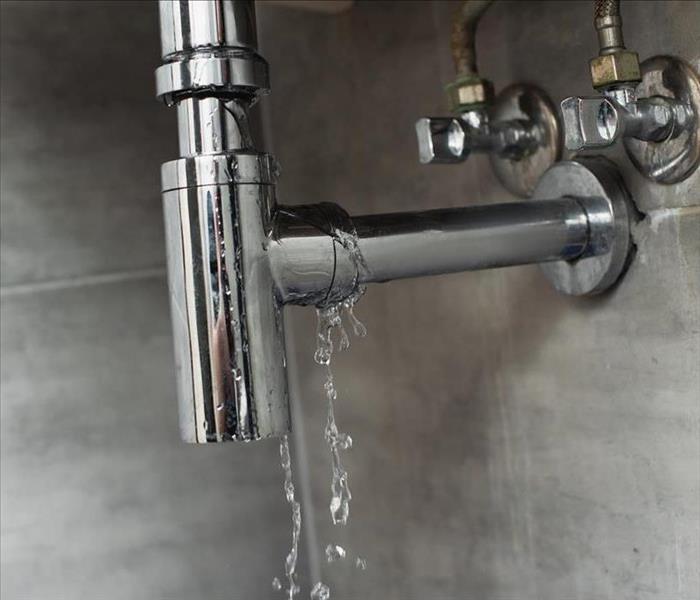 Contaminated water must be clean properly in your Colorado Springs, CO commercial.
Contaminated water must be clean properly in your Colorado Springs, CO commercial.
Category one water damage is defined as clean water. The problem likely stems from a freshwater line break. However, do not be fooled. While the source of the damage is initially uncontaminated water, it can and will evolve the longer it is left to fester.
As water sits on the floor, it becomes contaminated with bacteria, chemicals, and whatever else is on the floor, walls, or shelves and within the water. Therefore, it is crucial you deal with the water in your facility as quickly as possible.
3 Ways To Deal With Clean Water Damage
When dealing with the aftermath of a supply line break, time is of the essence. The water category can change rapidly, so if the spill is manageable, it is critical to wipe it up as soon as it is noticed. If it is a significant flood, contact a remediation specialist in Colorado Springs, CO, to manage the cleanup process. Either way, there is a four-step process to mitigating the problem.
1. Turn Off the Water Source
Before dealing with the growing flood on your facility floor, you will need to turn off the water supply to the affected area. If the spillage is in a kitchen or bathroom, you can often find the supply shut off under a sink or behind a toilet. If the problem occurs elsewhere in the building, it might be best to shut off the main water supply until you can locate the appropriate shutoff.
When working with a professional mitigation company, the team that arrives on the scene will probably know where the shutoffs are because they will have superior knowledge of plumbing systems. It is best to stay out of the pros way and let them do what they are trained to do.
2. Clean Up the Spillage or Overflow
Once the valve is off and there is no more water feeding into the flood, you can begin the cleanup process. You will need a mop, bucket, towels, etc., to dry the area as quickly as possible, limiting secondary damage.
A professional service will have access to commercial shop vacs, pumps, air movers, fans, etc., making the cleanup that much faster and more efficient. One thing to note is working with professionals almost always results in a quicker recovery time.
3. Call an Expert
Assuming the damage to the property is significant, resulting from a broken pipe, it is likely never better to try and DIY the project. A professional crew can remove more water in a small window than your company is likely equipped for, and speed and efficiency are crucial to mitigating any significant or lasting damage.
A clean water flood is typically referred to as a category one flood. As long as the disaster is cleaned up quickly, you can mitigate any significant damage. However, if the water sits for a long time, it will worsen to category two or three problems. When dealing with clean water or water disaster, like a minor or significant flood, it is likely in your best interest to hire a professional company.
How to Prevent Water Damage: Managing the Calm, So There is No Storm
8/17/2021 (Permalink)
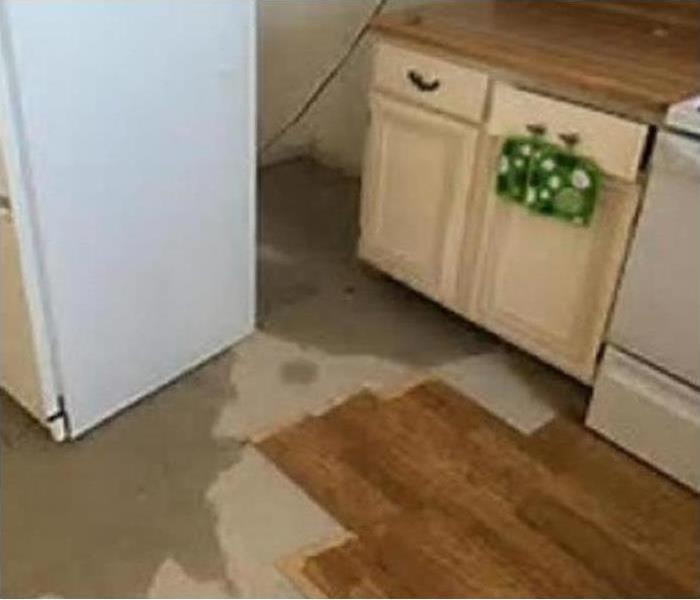 Leaking refrigerator supply line can lead to water damage to your Colorado Springs, CO, home
Leaking refrigerator supply line can lead to water damage to your Colorado Springs, CO, home
If faucets and drains function correctly, most homeowners don’t pay attention to water in the home. However, when that water is suddenly overflowing spaces and causing damage to property, homeowners take notice. The tips below will help you manage the calm now so that there are no water issues later.
1. Perform Routine Maintenance
Most elements of a home require routine maintenance to ensure that everything continues to function correctly, and this is no different for plumbing. Most plumbing systems should be cleaned out and inspected once or twice a year. This pipe cleanup and maintenance helps to protect your home from experiencing significant water damage.
2. Keep an Eye on Appliances
While water in the home is necessary for daily routines, care should be taken around appliances, both old and new. From small leaks behind the dishwasher to failed seals under the toilet, appliances are some of the most common culprits of water damage. Again, routine maintenance can help catch most of these issues before any significant problems occur.
3. Install Preventative Measures
A clogged or broken pipe can lead to extensive damage both cosmetically and structurally, but the installation of backflow valves and sump pumps can help to prevent any potential problems. Additionally, the installation of waterproofing systems and gutter systems can help to keep the lower levels of your home dry.
4. Conduct Bi-Annual Inspections
In addition to routine maintenance, you may want to conduct bi-annual inspections, spring, and fall, to pinpoint any areas of concern. Hiring a professional in Colorado Springs, CO, can be a wise choice because they will be equipped to give you a thorough understanding of the health of your home and its plumbing.
Again, water in the home is necessary, but it must be contained and controlled to prevent costly repairs and damage. Homeowners have a responsibility to their property, to maintain it and care for it. By performing routine maintenance, being mindful of appliances, and conducting regular inspections, homeowners can protect both their home and their family.
Dealing With the Aftermath of Broken Pipes in a Commercial Facility
8/13/2021 (Permalink)
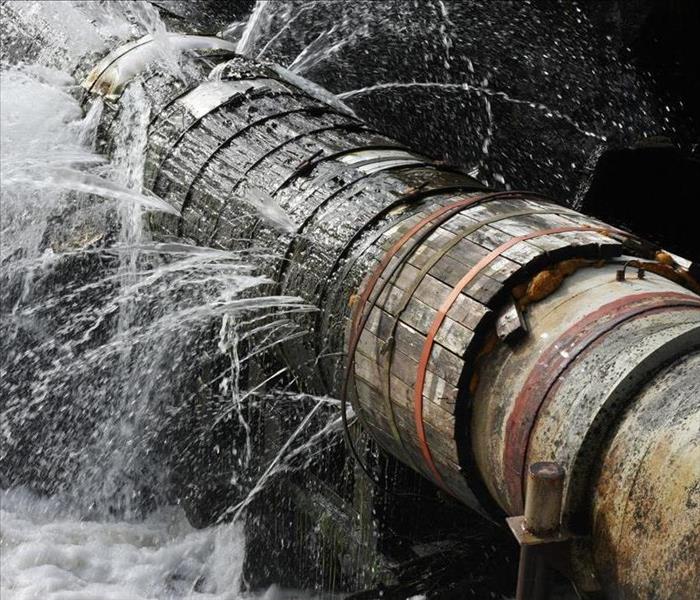 If the broken pipe is not fixed, further damages can come to your Colorado Springs, CO, business building.
If the broken pipe is not fixed, further damages can come to your Colorado Springs, CO, business building.
While most commercial facilities can experience a lifetime of business without dealing with bursting pipes throughout the facility, these problems do occur. Broken pipes are typically more common in facilities without temperature control and during the winter months, but such situations can occur at any time and with little warning.
When breaks occur, it is crucial to quickly deal with the problem to limit inventory and property damage. Businesses should contact a licensed water mitigation company in Colorado Springs, CO, for more information and to begin the recovery process. In the meantime, there are a few steps a business owner can take in the interim:
- Shut off the water supply
- Dry the affected area
- Remove valuable and salvageable inventory and assets
Remove the Water Source
Before a company can fix a broken pipe, it is necessary to eliminate the primary source of concern: the flowing water. A property manager should want to limit the risks of further flooding or inventory damage. If possible, cut off the water supply by only closing the valve to the affected area. If a controlled shutdown is not possible, locate the water main for the property and turn that off instead.
The primary concern is to stop the rush of water into other areas of the facility and to allow the swift removal of spillage from affected spaces. Bursting pipes can cause a lot of damage and quickly, so take care to acknowledge and account for any potential threats to you or your worker’s safety.
Do Not Allow Water To Sit For Too Long
The longer water spills out of the pipes, the more water damage in Colorado Springs, CO, will accumulate. Additionally, if you leave the water to pool and stand in an area, the more primary and secondary damage the property will experience.
The water spilling out of a broken pipe is most likely clean, but that does not mean the damage to the property is limited to minor issues. Mold is a significant concern after water leaks, and it can be costly and challenging to repair.
Removing water and drying the space quickly is essential to limit mold risks. However, unless you are sure the water damage results from a clean source and the area is safe for entry, leave the cleanup to the professionals.
Move Valuable and Salvageable Items to a Safe Dry Space
Once the affected area is dry and professionals have deemed it safe to enter, you and your team can begin removing inventory and assets. If there are any dry, unaffected items, it is best to start with these. For any objects in contact with the water, it is often best to work with a mitigation specialist to determine salvageability. Depending on the severity of the flooding, you will not manage to save everything, but a professional can help you select the items with the best repair potential.
While not every business will need to deal with burst pipes, those that do need to realize that a quick response is crucial to reducing the level of damage sustained. Following the above steps can help reduce many of your concerns and limit the odds of severe secondary damage.
5 Ways SERVPRO Serves Adjusters and Clients
6/28/2021 (Permalink)
 SERVPRO serves adjusters and clients
SERVPRO serves adjusters and clients
As an insurance adjuster, it is your job to provide quality service to your client, while also controlling costs for your employer. That is why SERVPRO franchises are set up to provide the best service to both adjusters and clients.
SERVPRO Provides Service to Both Adjusters and Clients
1. Fast Claims Processing
The number one goal of SERVPRO professionals is to restore your client's property “Like it never even happened." Customers appreciate the immediate response provided by locations in Colorado Springs, CO, which makes them happier with your service.
2. Cost Control
Restoring property costs less money than replacing it. Franchise professionals aim to restore wherever possible and replace only when necessary. Pretesting is performed on every insurance claim to determine which property can be restored and which must be replaced.
3. Complete Claims Information
The insurance adjuster won't have to chase restoration paperwork around to close a claim. Franchises furnish itemized loss inventories with pictures of critical items. Additionally, the claims information center provides a complete electronic job file, online access to all files, informative reports and performance comparisons.
4. Qualified and Well-Trained Staff
Clients and insurance companies can count on franchise staff because they are trained to IICRC standards for fire and water cleanup and restoration. Continuing education classes are made available to both franchise staff and insurance clients at an IICRC Approved Training Facility.
5. Compliance and Professionalism
Franchise professionals take their jobs seriously. They work hard to provide peace of mind to customers while performing fast, quality service. When you use SERVPRO you can focus on settling the claim without having to worry about any vendor problems. The performance of franchise professionals adds value for you, your managers, your customers and your shareholders.
The insurance adjuster and the client can rely on franchise professionals to be Faster to Any Size Disaster. Their highly-skilled technicians take the worry out of the restoration process so that everyone involved can focus on other things.
Supply Line Changes
4/7/2021 (Permalink)
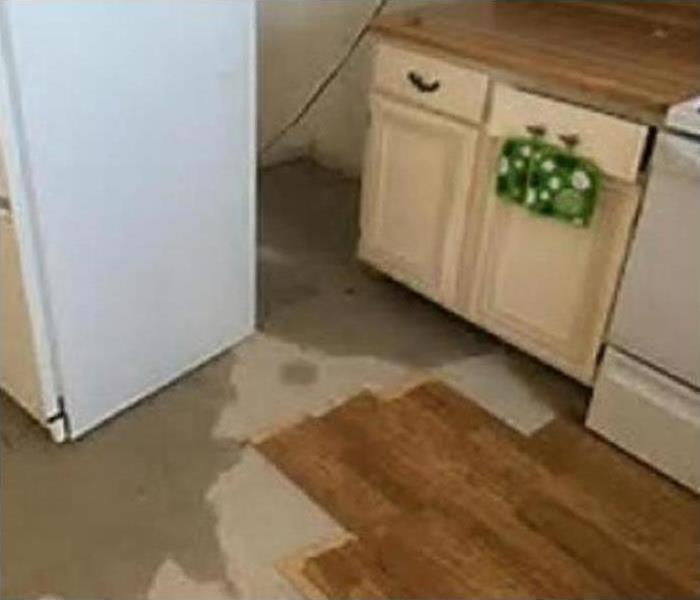 Supply line from a leaking refrigerator caused severe water damage.
Supply line from a leaking refrigerator caused severe water damage.
Your water supply lines in your home in Colorado Springs, CO, help to bring water into your home, ensuring appliances in your home such as toilets, showers, sinks and bathtubs have adequate water flow. As a homeowner, it's often useful to know about supply line damage and the importance of replacing supply lines.
FAQs About Supply Line Changes
What Are Signs of Damage to a Supply Line?
A damaged supply line can cause major damage to your home, and homeowners whose homes have sustained excessive amounts of water damage may find it useful to contact water damage restoration experts. There are several common signs that your supply line may be damaged, including:
- Mold growth near or around your supply line
- A musty odor in your bathroom
- A sudden, unexplained spike in your water bills
- Low water pressure in sinks or showers
- A bathroom leak
How Often Should You Replace Your Supply Line?
Different types of lines are prone to different types of supply line damage, and therefore, there isn't a set period of time that every line should be replaced. Plastic supply lines generally come with a warranty of about five to eight years; any point after this time, you may need to replace them. However, steel braided supply lines frequently come with a lifetime warranty and generally do not need to be replaced as frequently as plastic supply lines.
Can You Prevent Damage to Your Supply Lines?
Fortunately, there are steps you can take to prevent damage to your supply line. To prevent major damage, know common signs of supply line issues. If you do suspect a supply line leak, it's often important to quickly shut off the water in your home. If older lines or plastic lines need to be replaced, it can also be cost-effective long-term to install durable steel braided supply lines.
As with any element in your home, it can be wise to learn about supply lines. Though supply line damage has the potential to devastate your home, being knowledgeable about signs of damage, when to replace your supply line and how to prevent damage can help you to keep your supply lines functioning at their best.



 24/7 Emergency Service
24/7 Emergency Service













